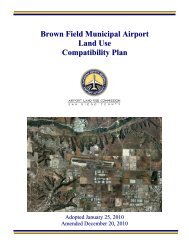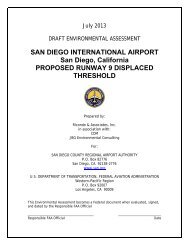MCAS Miramar Airport Land Use Compatibility Plan - San Diego ...
MCAS Miramar Airport Land Use Compatibility Plan - San Diego ...
MCAS Miramar Airport Land Use Compatibility Plan - San Diego ...
You also want an ePaper? Increase the reach of your titles
YUMPU automatically turns print PDFs into web optimized ePapers that Google loves.
AIRPORT LAND USE COMPATIBILITY CONCEPTSAPPENDIX Cstatistically valid. It is beyond the intent of this discussion to provide statistical data about aircraft accidents.However, certain aspects of aircraft accidents are necessary to discuss in that they have a directbearing on land use compatibility strategies.From the standpoint of land use planning, two variables determine the degree of risk posed by potentialaircraft accidents: frequency and consequences.Frequency VariableThe frequency variable measures where and when aircraft accidents occur in the vicinity of an airport.More specifically, these two elements can be described as follows: Spatial Element: The spatial element describes where aircraft accidents can be expected to occur.Of all the accidents that take place in the vicinity of airports, what percentage occurs in any givenlocation? Time Element: The time element adds a when variable to the assessment of accident frequency. Inany given location around a particular airport, what is the chance that an accident will occur in aspecified period of time?Of these two elements, the spatial element is the one most meaningfully applied to land use compatibilityplanning around an individual airport. Looking at airports nationwide, enough accidents have occurredto provide useful data regarding where they mostly occur in the environs of airports. Additionally,the relative concentration of accidents in certain parts of the airport environs is a key considerationin the establishment of compatibility criteria applicable within those zones.The U.S. Air Force has compiled data for military aircraft accidents and used it to define basic accidentpotential zones (APZs) for military airport runways. All branches of the military rely upon this analysis.The AICUZ for <strong>MCAS</strong> <strong>Miramar</strong> adjusts the basic APZs to follow the predominant flight corridors andto take into account the altitudes at which aircraft fly along these routes. The AICUZ also utilizes thedata on concentrations of accidents as one of the determinants of the degree of land use developmentrestrictions deemed appropriate within each zone. The ALUC is required to utilize the APZs, as providedin the ALCUZ, for purposes of preparation of the safety zones for the ALUCP.The time element, by way of contrast, is not very useful for land use compatibility planning purposesfor several reasons. First, at any given airport, the number of accidents is, with rare exceptions, too fewto be statistically meaningful in determining where future accidents might occur. Secondly, a calculationof accident frequency over time depends upon the size of the area under consideration—the smallerthe area examined, the less likely it is that an accident will occur in that spot.Consequences VariableThe consequences variable describes what happens when an aircraft accident occurs. Specific measurescan be defined in terms of deaths, injuries, property damage, or other such characteristics. In many respects,the consequences component of aircraft accident risk assessment is a more important variablethan accident frequency. Not only can a single accident cost many lives, it can indirectly force operationalchanges or even airport closure.Relatively little data is available specifically documenting the consequences of aircraft accidents. Exceptwith regard to numbers of deaths or injuries to people on the ground, data on various aspects of aircraftaccidents must be used to infer what the consequences have been. Swath size is one useful piece<strong>MCAS</strong> <strong>Miramar</strong> <strong>Airport</strong> <strong>Land</strong> <strong>Use</strong> <strong>Compatibility</strong> <strong>Plan</strong> (Adopted October 2008) C–9
















